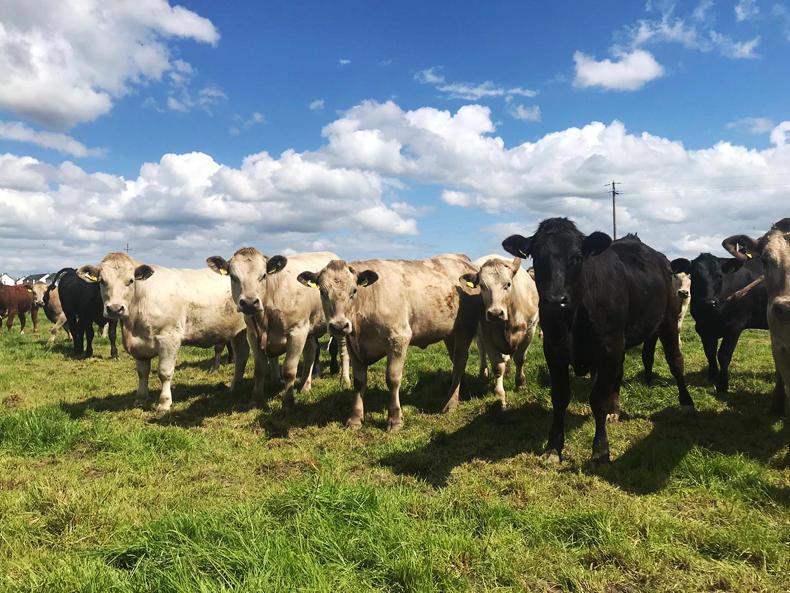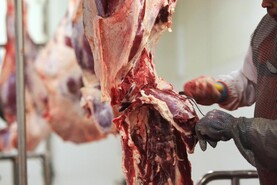Weighing of steers and heifers took place on Newford Farm on 19 June. Steers weighed 496kg on average, gaining 1.29kg since turnout on 23 March.
Steers have recovered a significant percentage of performance lost over the winter and are on a par with 2017-born steers weighed on the same date in 2018.
Heifers weighed 467kg on average, which translates to an average daily gain of 0.98kg since turnout on 26 February.
Analysis
Analysis by Teagasc's Michael Fagan shows that, in contrast to steers, heifers weigh 33kg more than their counterparts did on the same date 12 months ago.
It should be remembered that performance of 2017-born heifers was limited by heifers not getting to grass until May 2018.
According to farm manager Iarlaith Collins, steers look to be coming back on track, while heifers are also in good form with a good cover of flesh.
This should bode well, with a target of getting heifers drafted off grass and hopefully a percentage of steers.
Calf performance
2019-born calves were also weighed the week earlier on 14 June. The 47 male calves weighed 175kg on average.
With an average birth weight of 44kg and age of four months, this equates to an average daily gain of 1.23kg from birth.
The average weight of 60 heifers is just 4kg lighter at 1.71kg. The average birthweight of heifers was 38kg, with heifers gaining 1.22kg since birth.
According to Michael, these weights will also be used for the Beef Environmental Efficiency Programme (BEEP).
Table 1 shows the grassland position as of 17 June.
The 3.7ha silage area listed on the Newford block are paddocks which were mowed on Friday and will be baled on Saturday.

Paddocks being mowed on Newford Farm on Friday. They will be allowed to wilt for 24 hours and baled on Saturday.
Growth is holding strong on this block and was recorded at 78kg DM/ha for the week. A half a bag of protected urea with sulphur is being applied after each grazing.
As the farm is still waiting on additional land which has been recently reseeded to join the project, there was only a small area of ground closed for first-cut silage.
The focus has been on driving grass output to secure as many bales of the three grazing areas as possible before closing a significant area of ground for a second cut when the new parcel of land enters the grazing rotation.
To date, there has been 375 bales of silage saved in this manner, with an additional 40 bales collected on a small area closed for a first cut.
Weighing of steers and heifers took place on Newford Farm on 19 June. Steers weighed 496kg on average, gaining 1.29kg since turnout on 23 March.
Steers have recovered a significant percentage of performance lost over the winter and are on a par with 2017-born steers weighed on the same date in 2018.
Heifers weighed 467kg on average, which translates to an average daily gain of 0.98kg since turnout on 26 February.
Analysis
Analysis by Teagasc's Michael Fagan shows that, in contrast to steers, heifers weigh 33kg more than their counterparts did on the same date 12 months ago.
It should be remembered that performance of 2017-born heifers was limited by heifers not getting to grass until May 2018.
According to farm manager Iarlaith Collins, steers look to be coming back on track, while heifers are also in good form with a good cover of flesh.
This should bode well, with a target of getting heifers drafted off grass and hopefully a percentage of steers.
Calf performance
2019-born calves were also weighed the week earlier on 14 June. The 47 male calves weighed 175kg on average.
With an average birth weight of 44kg and age of four months, this equates to an average daily gain of 1.23kg from birth.
The average weight of 60 heifers is just 4kg lighter at 1.71kg. The average birthweight of heifers was 38kg, with heifers gaining 1.22kg since birth.
According to Michael, these weights will also be used for the Beef Environmental Efficiency Programme (BEEP).
Table 1 shows the grassland position as of 17 June.
The 3.7ha silage area listed on the Newford block are paddocks which were mowed on Friday and will be baled on Saturday.

Paddocks being mowed on Newford Farm on Friday. They will be allowed to wilt for 24 hours and baled on Saturday.
Growth is holding strong on this block and was recorded at 78kg DM/ha for the week. A half a bag of protected urea with sulphur is being applied after each grazing.
As the farm is still waiting on additional land which has been recently reseeded to join the project, there was only a small area of ground closed for first-cut silage.
The focus has been on driving grass output to secure as many bales of the three grazing areas as possible before closing a significant area of ground for a second cut when the new parcel of land enters the grazing rotation.
To date, there has been 375 bales of silage saved in this manner, with an additional 40 bales collected on a small area closed for a first cut.







 This is a subscriber-only article
This is a subscriber-only article










SHARING OPTIONS: